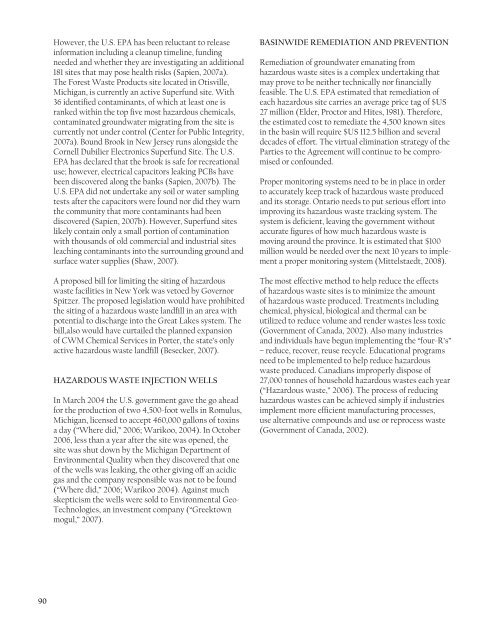Groundwater in the Great Lakes Basin
Groundwater in the Great Lakes Basin
Groundwater in the Great Lakes Basin
Create successful ePaper yourself
Turn your PDF publications into a flip-book with our unique Google optimized e-Paper software.
However, <strong>the</strong> U.S. EPA has been reluctant to release<br />
<strong>in</strong>formation <strong>in</strong>clud<strong>in</strong>g a cleanup timel<strong>in</strong>e, fund<strong>in</strong>g<br />
needed and whe<strong>the</strong>r <strong>the</strong>y are <strong>in</strong>vestigat<strong>in</strong>g an additional<br />
181 sites that may pose health risks (Sapien, 2007a).<br />
The Forest Waste Products site located <strong>in</strong> Otisville,<br />
Michigan, is currently an active Superfund site. With<br />
36 identified contam<strong>in</strong>ants, of which at least one is<br />
ranked with<strong>in</strong> <strong>the</strong> top five most hazardous chemicals,<br />
contam<strong>in</strong>ated groundwater migrat<strong>in</strong>g from <strong>the</strong> site is<br />
currently not under control (Center for Public Integrity,<br />
2007a). Bound Brook <strong>in</strong> New Jersey runs alongside <strong>the</strong><br />
Cornell Dubilier Electronics Superfund Site. The U.S.<br />
EPA has declared that <strong>the</strong> brook is safe for recreational<br />
use; however, electrical capacitors leak<strong>in</strong>g PCBs have<br />
been discovered along <strong>the</strong> banks (Sapien, 2007b). The<br />
U.S. EPA did not undertake any soil or water sampl<strong>in</strong>g<br />
tests after <strong>the</strong> capacitors were found nor did <strong>the</strong>y warn<br />
<strong>the</strong> community that more contam<strong>in</strong>ants had been<br />
discovered (Sapien, 2007b). However, Superfund sites<br />
likely conta<strong>in</strong> only a small portion of contam<strong>in</strong>ation<br />
with thousands of old commercial and <strong>in</strong>dustrial sites<br />
leach<strong>in</strong>g contam<strong>in</strong>ants <strong>in</strong>to <strong>the</strong> surround<strong>in</strong>g ground and<br />
surface water supplies (Shaw, 2007).<br />
A proposed bill for limit<strong>in</strong>g <strong>the</strong> sit<strong>in</strong>g of hazardous<br />
waste facilities <strong>in</strong> New York was vetoed by Governor<br />
Spitzer. The proposed legislation would have prohibited<br />
<strong>the</strong> sit<strong>in</strong>g of a hazardous waste landfill <strong>in</strong> an area with<br />
potential to discharge <strong>in</strong>to <strong>the</strong> <strong>Great</strong> <strong>Lakes</strong> system. The<br />
bill,also would have curtailed <strong>the</strong> planned expansion<br />
of CWM Chemical Services <strong>in</strong> Porter, <strong>the</strong> state’s only<br />
active hazardous waste landfill (Besecker, 2007).<br />
Hazardous Waste Injection Wells<br />
In March 2004 <strong>the</strong> U.S. government gave <strong>the</strong> go ahead<br />
for <strong>the</strong> production of two 4,500-foot wells <strong>in</strong> Romulus,<br />
Michigan, licensed to accept 460,000 gallons of tox<strong>in</strong>s<br />
a day (“Where did,” 2006; Warikoo, 2004). In October<br />
2006, less than a year after <strong>the</strong> site was opened, <strong>the</strong><br />
site was shut down by <strong>the</strong> Michigan Department of<br />
Environmental Quality when <strong>the</strong>y discovered that one<br />
of <strong>the</strong> wells was leak<strong>in</strong>g, <strong>the</strong> o<strong>the</strong>r giv<strong>in</strong>g off an acidic<br />
gas and <strong>the</strong> company responsible was not to be found<br />
(“Where did,” 2006; Warikoo 2004). Aga<strong>in</strong>st much<br />
skepticism <strong>the</strong> wells were sold to Environmental Geo-<br />
Technologies, an <strong>in</strong>vestment company (“Greektown<br />
mogul,” 2007).<br />
BASINWIDE REMEDIATION AND PREVENTION<br />
Remediation of groundwater emanat<strong>in</strong>g from<br />
hazardous waste sites is a complex undertak<strong>in</strong>g that<br />
may prove to be nei<strong>the</strong>r technically nor f<strong>in</strong>ancially<br />
feasible. The U.S. EPA estimated that remediation of<br />
each hazardous site carries an average price tag of $US<br />
27 million (Elder, Proctor and Hites, 1981). Therefore,<br />
<strong>the</strong> estimated cost to remediate <strong>the</strong> 4,500 known sites<br />
<strong>in</strong> <strong>the</strong> bas<strong>in</strong> will require $US 112.5 billion and several<br />
decades of effort. The virtual elim<strong>in</strong>ation strategy of <strong>the</strong><br />
Parties to <strong>the</strong> Agreement will cont<strong>in</strong>ue to be compromised<br />
or confounded.<br />
Proper monitor<strong>in</strong>g systems need to be <strong>in</strong> place <strong>in</strong> order<br />
to accurately keep track of hazardous waste produced<br />
and its storage. Ontario needs to put serious effort <strong>in</strong>to<br />
improv<strong>in</strong>g its hazardous waste track<strong>in</strong>g system. The<br />
system is deficient, leav<strong>in</strong>g <strong>the</strong> government without<br />
accurate figures of how much hazardous waste is<br />
mov<strong>in</strong>g around <strong>the</strong> prov<strong>in</strong>ce. It is estimated that $100<br />
million would be needed over <strong>the</strong> next 10 years to implement<br />
a proper monitor<strong>in</strong>g system (Mittelstaedt, 2008).<br />
The most effective method to help reduce <strong>the</strong> effects<br />
of hazardous waste sites is to m<strong>in</strong>imize <strong>the</strong> amount<br />
of hazardous waste produced. Treatments <strong>in</strong>clud<strong>in</strong>g<br />
chemical, physical, biological and <strong>the</strong>rmal can be<br />
utilized to reduce volume and render wastes less toxic<br />
(Government of Canada, 2002). Also many <strong>in</strong>dustries<br />
and <strong>in</strong>dividuals have begun implement<strong>in</strong>g <strong>the</strong> “four-R’s”<br />
– reduce, recover, reuse recycle. Educational programs<br />
need to be implemented to help reduce hazardous<br />
waste produced. Canadians improperly dispose of<br />
27,000 tonnes of household hazardous wastes each year<br />
(“Hazardous waste,” 2006). The process of reduc<strong>in</strong>g<br />
hazardous wastes can be achieved simply if <strong>in</strong>dustries<br />
implement more efficient manufactur<strong>in</strong>g processes,<br />
use alternative compounds and use or reprocess waste<br />
(Government of Canada, 2002).<br />
90

















